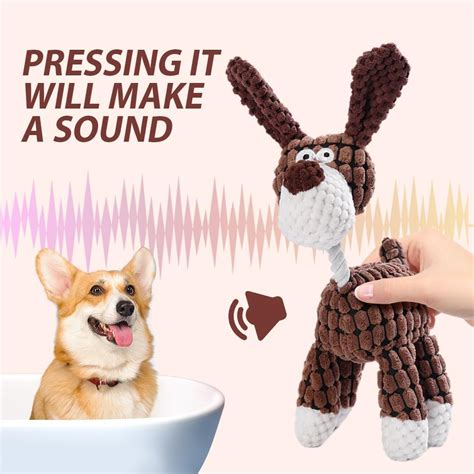The Ultimate Battle: Squeaky Toys VS Chew Toys
Introduction:

In the realm of canine companions, toys and chews hold a special place. They provide hours of entertainment, mental stimulation, and dental hygiene. However, choosing the right ones for your furry friend can be a daunting task. In this comprehensive guide, we dive into the world of dog toys and chews, exploring their benefits, types, and considerations to help you make an informed decision for your beloved pooch.
Types of Dog Toys and Chews
Toys
– Squeaky Toys: These toys emit a high-pitched sound when squeezed, appealing to dogs’ natural prey drive and providing endless entertainment.
– Plush Toys: Soft and cuddly, plush toys offer comfort and companionship, especially for young puppies or anxious dogs.
– Puzzle Toys: Designed to challenge dogs mentally, these toys require them to solve puzzles to access treats or kibble, stimulating their cognitive abilities.
– Fetch Toys: Toys like balls, frisbees, and sticks encourage physical activity and promote bonding between dogs and their owners.
Chews
– Dental Chews: Specifically designed to promote dental hygiene, these chews help remove plaque and tartar, reducing the risk of gum disease and tooth decay.
– Rawhide Chews: Made from the dried skin of animals, rawhide chews provide a tough and satisfying chew that can help clean dogs’ teeth and reduce boredom.
– Bully Sticks: Bully sticks are highly digestible chews made from beef or pork pizzle. They are a great source of protein and help satisfy dogs’ natural chewing instincts.
– Nylabone Chews: Made from durable nylon, Nylabone chews are designed to withstand even the most aggressive chewers and provide long-lasting entertainment.
Benefits of Dog Toys and Chews
Entertainment: Toys and chews provide dogs with hours of amusement, reducing boredom and promoting mental well-being.
Dental Hygiene: Dental chews specifically designed to promote dental hygiene, reduce the risk of gum disease and tooth decay.
Mental Stimulation: Puzzle toys challenge dogs mentally, improving their cognitive abilities and keeping them engaged.
Bonding: Fetch toys and other interactive toys promote bonding between dogs and their owners, strengthening their relationship.
Pain Relief: Chewing can provide pain relief to dogs experiencing teething or jaw pain.
Stress Relief: Toys and chews can help dogs relieve stress and anxiety by providing a sense of comfort and security.
Considerations for Choosing Dog Toys and Chews
Size
Consider the size of your dog when choosing toys and chews. Small toys can be a choking hazard for large dogs, while large toys may be too heavy or bulky for small breeds.
Chewing Style
Match the toughness of the toy or chew to your dog’s chewing style. Aggressive chewers may require more durable toys like Nylabone chews, while gentle chewers may prefer softer options like plush toys.
Age
Puppies and senior dogs have different chewing needs. Choose soft, pliable toys for puppies and older dogs with weaker teeth.
Health Conditions
Consider your dog’s health conditions when selecting toys and chews. Avoid toys with small parts or sharp edges for dogs with certain dental or digestive issues.
Supervision
Always supervise your dog when they are playing with toys or chews. This ensures their safety and prevents potential hazards.
Tips and Tricks
- Rotate Toys: Offer your dog a variety of toys and chews to keep them interested and prevent boredom.
- Use Treats: Hide treats inside puzzle toys to make them more challenging and rewarding.
- Play Interactive Games: Use fetch toys and other interactive toys to engage your dog mentally and physically.
- Inspect Regularly: Check toys and chews for damage or wear and replace them as needed to prevent choking hazards.
- Consider Different Textures: Provide toys with various textures to appeal to your dog’s different chewing preferences.
Common Mistakes to Avoid
- Choosing the Wrong Size: Selecting toys or chews that are too small or too large can be dangerous for your dog.
- Ignoring Supervision: Failing to supervise your dog while they are using toys or chews can lead to choking or other injuries.
- Overfeeding with Chews: Giving your dog excessive amounts of chews can lead to weight gain and digestive issues.
- Using Toys for Punishment: Toys and chews should be positive experiences for dogs. Avoid using them as punishment, as this can damage your relationship with your pet.
- Neglecting Dental Care: While dental chews can help maintain dental hygiene, they cannot replace regular dental checkups and cleanings.
Step-by-Step Approach to Choosing the Right Dog Toys and Chews
- Determine your dog’s size, age, chewing style, and health conditions.
- Research different types of toys and chews to find those that best suit your dog’s needs.
- Purchase a variety of toys and chews to keep your dog entertained and stimulated.
- Supervise your dog while they are using toys or chews to ensure their safety.
- Rotate toys and chews regularly to maintain interest and prevent boredom.
Conclusion
Dog toys and chews play a vital role in the well-being of our furry companions. By understanding the different types, benefits, and considerations involved, you can make informed decisions that enhance your dog’s life. Remember to supervise your dog, rotate toys regularly, and avoid common mistakes to ensure a safe and enjoyable experience for both you and your beloved pooch.





















